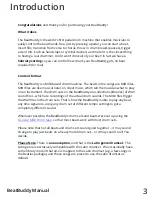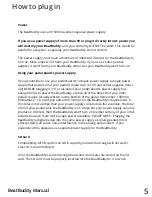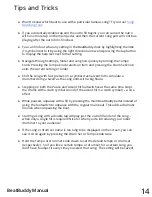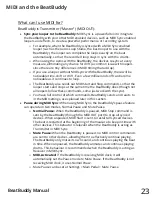
8
How to plug in
BeatBuddy Manual
If you have the BeatBuddy plugged into an amp,
any effects on the amp will
affect the sound of your BeatBuddy (unless the BeatBuddy is plugged into your
amp’s AUX jack, then it is fine). So if your amp’s distortion is on, the beats will sound
distorted. It is highly recommended to have your amp set to a ‘clean’, neutral tone
for the best sound and use effects pedals instead of the amp’s effects if you wish to
have effects on your instrument sound. If you are using the BeatBuddy with other
pedals, it is recommended to place the BeatBuddy after all of the other pedals in
the effects chain so that the BeatBuddy’s sound isn’t affected by your other pedals.
The BeatBuddy will never damage your amp’s speaker through normal use. Though,
if you prefer using your amp exclusively for your instrument, you may use a
separate amp for the BeatBuddy. This will also allow you to enjoy the built in effects
of your main amp for your guitar without affecting the BeatBuddy’s drum sounds.
One additional issue that may arise from using the same amp to play your guitar
and the BeatBuddy’s beats is that on some amps, the sound of the bass drum will
cause the guitar to tremolo, or waver, a bit to the beat. While some people love this
effect -- if you would like to reduce it, lower the Bass (Low) setting on your amp.
MIDI Connection
What is MIDI Sync?
It is the transfer of MIDI Clock between two devices allowing
them to become synchronized to the same time reference. The BeatBuddy can
send and/or receive MIDI Clock, MIDI time signature, and MIDI Start, Stop, and
transition (CC:102, see
ection 8 MIDI and the BeatBuddy
) messages once
connected to another device via MIDI.
In order to connect the BeatBuddy via MIDI, you need 2 cables: A
, and a standard male to male 5-pin MIDI cable.
The MIDI Sync Breakout cable has 3 ends: the small, singular end which connects to
the BeatBuddy and the two split female MIDI ports (labelled IN and OUT) which
connect to a standard MIDI cable. If the BeatBuddy is behaving as the
transmitter
(
master
)
MIDI device, connect the
receiver (
slave
)
device to the OUT port on the
MIDI Sync Breakout cable using the standard MIDI cable. If the BeatBuddy is
behaving as the
receiver
MIDI device, connect the
transmitter
device to the IN port
on the MIDI Sync Breakout cable using the standard MIDI Cable. You must use the
standard male to male 5-pin MIDI cable to connect the other device to the MIDI
Sync Breakout cable (See Graphics On Next Page).


































